Microirrigation in landscape beds
- Home
- /
- Technical Manual
- /
- Irrigation system criteria
- /
- General design
- /
- Microirrigation in landscape beds
Background
Microirrigation is defined as the frequent application of small quantities of water directly on or below the soil surface or plant root zone, usually as discrete drops, tiny streams or miniature sprays through emitters placed along the water delivery pipes (laterals). Microirrigation encompasses a number of methods or concepts, including drip (previously known as trickle irrigation), subsurface, bubbler and microspray irrigation. Microirrigation emitters apply less than 30 gallons per hour (gph) or 0.5 gallons per minute (gpm). (Landscape Irrigation and Florida-Friendly Design Standards)
Most types of microirrigation deliver water below the plant canopy and directly to the root ball, resulting in higher application efficiencies than sprinklers. Florida Water Star encourages the use of microirrigation for landscape beds. Higher application efficiencies allow for effective irrigation while using less water than sprinklers. Lower application rates allow more time for water to infiltrate the soil, thus reducing the likelihood of runoff.
| Microirrigation Emitter Types | |
|---|---|
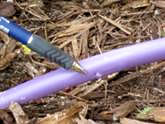 In-line drip
|
|
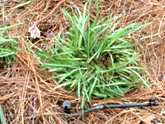 Point source emitter |
|
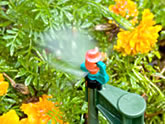 Microspray sprinkler |
|
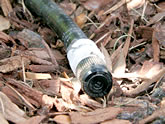 Bubbler |
|
Microirrigation systems require increased maintenance, in comparison to high-volume irrigation systems. Components can be damaged or caused to malfunction if water pressure is too high, and the correct installation of pressure regulation is necessary. Clogging can occur because microirrigation emitters have smaller orifices than high-volume sprinklers. It is usually necessary to install filters and flush valves to prevent clogging, especially when reclaimed water is used. Microirrigation components are often installed aboveground, and they can be more vulnerable to inadvertent damage from wildlife and sunlight, or exposure to weather.
Microirrigation Recommendations
Adapted from A Guide to Micro-Irrigation for West-Central Florida Landscapes
(Source: Tampa Bay Water)
- Do not run ½-inch poly tubing more than 250 feet.
- Do not run ¼-inch spaghetti tubing more than 5 feet.
- Use buried PVC pipe or poly tubing to deliver water closer to the irrigated area.
- Place emitters so they are evenly spaced around plants; for example, emitter should be placed halfway between a tree’s trunk and the canopy edge.
- Install micro-sprays to provide head-to-head coverage.
- For large trees, potted plants and hanging baskets, additional rows and/or emitters may be necessary to meet the plants’ water needs.
- Maintain plant health by moving emitters away from plants as they mature to encourage proper root development.
Due to smaller emitters, tubing and other components, microirrigation might require pressure regulation, filtration and flush valves to prevent clogging and damage from high water pressure.
The following factors must be considered when designing emitter spacing:
- Microirrigation should be tailored to the plant material that it will irrigate. In-line drip in a grid pattern might be appropriate for ground cover, while point-source emitters are better suited to a zone with different-sized shrubs.
- Soil plays a significant role in microirrigation system design. Particularly, emitter and drip line spacing must be determined based on soil texture. Spacing should be narrower for sandy soils and wider for clay soils.
- Building use (high/low foot traffic): Microirrigation devices such as microsprays might not be suitable for high-traffic areas.
Requirements and certification
If irrigation is used for landscape beds, micro-irrigation is installed.
| Silver | Gold | Commercial/Institutional |
|---|---|---|
| Required | Required | NA |
In addition, designers and installers should refer to the manufacturer’s recommendations for correct installation guidelines.
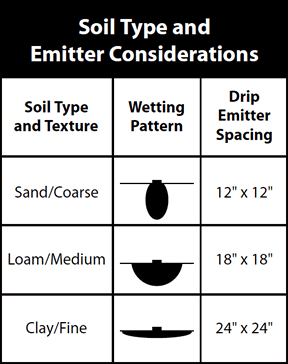
Program tip
If microirrigation components are not directly visible, the Inspector must manually remove mulch in multiple areas to confirm its presence and correct the installation. Inspectors should replace any mulch that was displaced during microirrigation inspection.
While it is not a requirement of Florida Water Star certification, reducing ultraviolet (UV) exposure to microirrigation tubing can greatly increase its longevity. Covering tubing with mulch/soil and staking it to the ground can reduce the tendency for drip tubing to rise from the soil. This may prevent UV exposure.
In certain conditions, as plants mature, emitters might need to be moved away from the plant base to promote root development.
